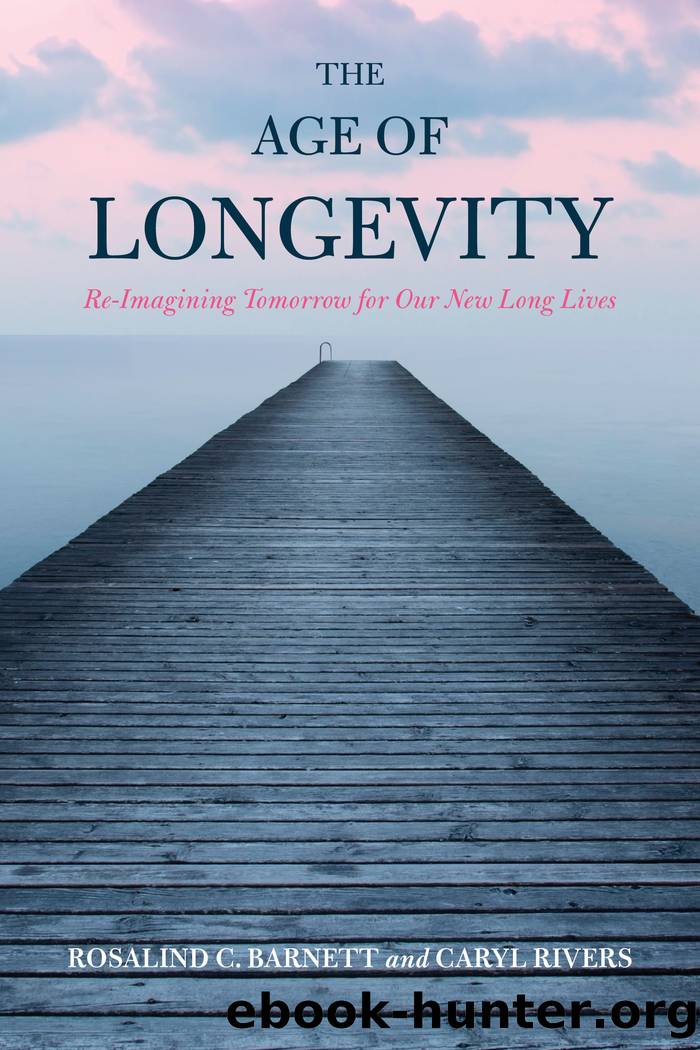The Age of Longevity by Rosalind C. Barnett

Author:Rosalind C. Barnett
Language: eng
Format: epub
Tags: undefined
Publisher: Rowman & Littlefield Publishers
Published: 2012-09-15T00:00:00+00:00
Retying the Knot
Even as gray divorce increases, the desire to remarry remains strong. As a result of the dramatic changes in marriage and divorce that weâve described, there has been an increase in the pool of adults who could potentially remarry.
In the age of longevity, more and more adults will be âavailableâ for remarriage. Boomers were the first cohort âto divorce and remarry in large numbers during young adulthood.â[47] In their words, âNow, they are aging into their 50s and 60s, and this portends a growing number of older adults will experience divorce since remarriages are more likely than first marriages to end through divorce.â Widows and widowers are also candidates for remarriage. Both groups have more years âin which to make, dissolve, and remake unions.â
It seems that previously married people are as willing as ever to jump back into wedlock. Among adults who are presently married, about a quarter (23 percent) have been married before, compared with 13 percent in 1960. Among older people, remarriage is more attractive for men than women. Only 30 percent of single men are uninterested in remarrying, compared to the majority of women, 54 percent.[48]
In the future, people in late adulthood will look more favorably on remarriage. âOlder adults have become ever more likely to remarry, perhaps due in part to a desire to have a fulfilling relationship in their lengthening golden years, as life expectancies have increased. Fully half (50%) of previously married seniors had remarried in 2013, up from 34% in 1960.â[49]
This trend has opened up a yawning economic divide. Not surprisingly, married people tend to be much better off financially than those who are unmarried, and those who have fewer assets and more debt early on are less likely to marry or have stable marriages than those who are more financially secure.
Among the less well educated, the number of married households has fallen even more.[50] Sixty-four percent of college-educated Americans are married, compared to fewer than 48 percent of those with some college or less. In 1960, the report found, the two groups were about equally likely to be married.
Money is often a major consideration for older couples deciding whether or not to cohabit or marry. Social security income is a large chunk of the income of many late adults, and its maze-like rules often tip the scales against remarriage. âFor those whoâve been married previously, Social Security commonly pays two types of benefits: spousal benefits (for divorced spouses who qualify) and survivors benefits (for those whose spouses have passed away). But of course, being divorced or widowed doesnât mean youâre destined to stay alone. New love may surprise you. But if that relationship grows, it could lead to a much less pleasant surprise: discontinued Social Security benefits,â warns Daily Finance.[51]
Social Security gives many divorced spouses the same payout theyâd be entitled to if they stayed married. If you were married for at least 10 years, then you are eligible for benefits based on your ex-spouseâs work history.
But if you remarry, there can be serious risks.
Download
This site does not store any files on its server. We only index and link to content provided by other sites. Please contact the content providers to delete copyright contents if any and email us, we'll remove relevant links or contents immediately.
Spare by Prince Harry The Duke of Sussex(4994)
Machine Learning at Scale with H2O by Gregory Keys | David Whiting(3968)
Fairy Tale by Stephen King(3156)
Will by Will Smith(2734)
Hooked: A Dark, Contemporary Romance (Never After Series) by Emily McIntire(2463)
The Bullet Journal Method by Ryder Carroll(2436)
Rationality by Steven Pinker(2228)
It Starts With Us (It Ends with Us #2) by Colleen Hoover(2150)
Friends, Lovers, and the Big Terrible Thing by Matthew Perry(2078)
Can't Hurt Me: Master Your Mind and Defy the Odds - Clean Edition by David Goggins(2068)
The Becoming by Nora Roberts(2030)
Love on the Brain by Ali Hazelwood(1905)
HBR's 10 Must Reads 2022 by Harvard Business Review(1738)
A Short History of War by Jeremy Black(1724)
The Strength In Our Scars by Bianca Sparacino(1722)
Leviathan Falls (The Expanse Book 9) by James S. A. Corey(1602)
515945210 by Unknown(1563)
A Game of Thrones (The Illustrated Edition) by George R. R. Martin(1502)
Bewilderment by Richard Powers(1494)
